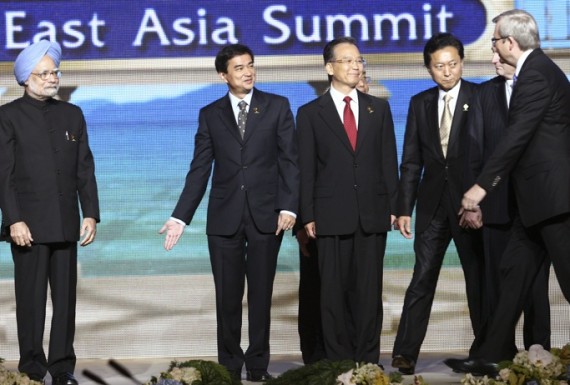East Asia Summit, Take Two
More on:

A post over at East Asia Forum tweaks my recent blog about America and the East Asia Summit. It argues that I have an "empathy deficit." Here’s how the post puts it: "Asian partners have good reason for concern" because Americans—on a bipartisan basis—have a tendency to "dismiss proposals for greater engagement with institutions that are not ‘results-focused.’" We "fail to grasp that concerns about regional institution building are based as much upon a preoccupation with the construction of regional identity as they are on economic arrangements or the balance of power."
Actually, I grasp that pretty well. To a very great extent, Asian institution building has been about identity. Or, more precisely, it’s been about “community building,” not just results.
But for one thing, that’s exactly why Americans shouldn’t balk at every pan-Asian institution that doesn’t include the United States. And for that matter, it’s also why Americans should desist from trying to slam down the door of every single regional institution, often just for the sake of it.
Washington can hardly tell the world’s leading economies that they are not allowed to speak to one another without Americans in every room and in every conversation. Nor do Americans get to have NAFTA or a Free Trade Area of the Americas while telling Asians they cannot pursue pan-Asian trade arrangements. Some pan-Asian formations are inevitable, in part because Asians have been searching for a more coherent regional identity for decades.
So, if the United States both respects Asia’s search for community and cares about results, it’s going to need to find a way to distinguish between the tables where it "must" sit and those from which it can afford to just step aside.
After all, the U.S. isn’t in the EU. It isn’t in the GCC. It isn’t in the AU. It isn’t in the SCO. It isn’t in the CSTO. It isn’t in the OIC. And it isn’t in six-dozen other organizations around the world. What’s the message to Asians if Americans insist that only their region is the exception? And does the United States truly need to be everywhere? Indeed, since it probably can’t be everywhere, why shouldn’t it focus primarily on those institutions that affect its interests, for good or for ill, in concrete ways?
We risk forgetting history here: The 1997-98 financial crisis was an inflection point—a moment at which elites across East Asia came to view the United States as arrogant and aloof, dictating clichéd solutions to skeptical Asians. The United States, which bailed out Mexico in 1994, refused to bail out Thailand just three years later. That fueled perceptions that the U.S. neglected Southeast Asia. And the United States continues to pay a price for those perceptions to this day.
The events of 1997-98 helped to spur Asia’s turn away from APEC in favor of the ASEAN Plus Three. And today, it is ASEAN Plus Three—a group that has no intention whatsoever of including the United States—that has become by far the most coherent and substantive pan-Asian grouping.
So, here’s my point: While the United States has been debating what to do about EAS, it is ASEAN Plus Three, as well as the China-Japan-South Korea “Plus Three," that have steadily forged ahead—without Washington, and on issues and agendas that should matter greatly to Washington. In that sense, identity is converging with sheer economic reality but not at all to American advantage.
At the same time, let’s not forget that Asian institution building hasn’t been solely about identity and community, either. Asians, no less than Americans, care deeply about results. And they certainly care about “economic arrangements and the balance of power.”
At its inception, ASEAN sought, in part, to balance Chinese power. ASEAN sought to integrate the Indochinese states after 1975 for strategic reasons. And since then, Southeast Asian countries have themselves sought to foster greater balance by discussing maritime claims with Beijing collectively. Indeed, in recent weeks—from exercises in the Yellow Sea to discussions of the South China Sea at the ASEAN Regional Forum (ARF)—we have seen, once again, that it isn’t just Americans who care about power balances and their effects.
Ultimately, Americans do need to understand that, for many Asians, the search for a common identity matters. It has been integral both to Asian regionalism and to Asian institution building. But a proper respect for Asian efforts to fashion greater community produces precisely the same prescription as my focus on “results”—the United States ought to focus principally on the institutions that actually matter to its political, economic, and security interests.
For the United States, the cardinal rule in Asia remains, “show up.” There’s just no substitute for intensive American engagement. But when we get down to the brass tacks of this or that institution, it’s time the United States began a different kind of conversation with its Asian partners—focused on a more purposeful and, yes, a more functional multilateralism that respects Asia’s trajectory while redefining how and where the United States fits into a 21st century Asia.
If the U.S. is, as it appears, truly determined to join EAS, the very least the administration can do is to try to build in some real capabilities. EAS needs to do something. The good news is that the administration’s Asia team understands that. And EAS at least has the virtue of including the right players.
One last point: Inevitably, U.S. membership in EAS will reduce the role of the ASEAN Regional Forum (ARF). So perhaps the recent ARF meeting in Hanoi—where 12 nations offered complementary perspectives and approaches to freedom of navigation in the South China Sea—offers an example for EAS of how to make political discussions current and meaningful? It’s a model that won’t sit well with Beijing, to be sure. But at least EAS would, in time, become more than just another leaders’ group-grope.
More on:
 Online Store
Online Store
